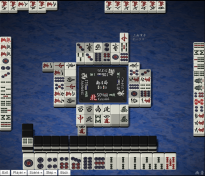Sashikomi: Difference between revisions
Jump to navigation
Jump to search
No edit summary |
m (→External links: removing empty section) |
||
| (7 intermediate revisions by 3 users not shown) | |||
| Line 1: | Line 1: | ||
[[Image:Sashikomi.png|thumb|205px|right|[http://tenhou.net/0/?log=2015071312gm-0089-0000-c9d124b2&tw=2&ts=9 Sashikomi utilized] with minimal risk of [[gyakuten]], while ending the game.]] | [[Image:Sashikomi.png|thumb|205px|right|[http://tenhou.net/0/?log=2015071312gm-0089-0000-c9d124b2&tw=2&ts=9 Sashikomi utilized] with minimal risk of [[gyakuten]], while ending the game.]] | ||
'''Sashikomi''' {{kana|差し込み}} is the deliberate act of dealing dangerous tiles | '''Sashikomi''' {{kana|差し込み}} is the deliberate act of dealing dangerous tiles in order for another player to win the hand. The main purpose of this strategy is to end the game quicker, or sometimes, to not let a certain player win. Normally, players with a large enough lead can take the point loss and remain first. | ||
==Usage== | |||
Sashikomi is usually used by players with a sizable lead, or players with a marginal point lead vs the next player in placement. | |||
The following is useful when using this strategy: | |||
*Knowledge of the [[scoring table]]. | |||
*The ability to read discards and/or the gamestate helps (e.g. if all a player needs is a quick hand, they'll probably make a cheap hand, which makes it safer to deal into them). | |||
Sashikomi always requires you to defend against a specific player. For example, when trying to end the game faster, defend against the [[dealer]] to prevent [[renchan|additional hands]]. Therefore, sashikomi would mean dealing into either non-dealer (while avoiding the dealer). | |||
[[Category:Strategy]] | |||
[[Category:Terminology]] | |||
{{Navbox strategy}} | {{Navbox strategy}} | ||
Latest revision as of 13:25, 1 April 2025

Sashikomi 「差し込み」 is the deliberate act of dealing dangerous tiles in order for another player to win the hand. The main purpose of this strategy is to end the game quicker, or sometimes, to not let a certain player win. Normally, players with a large enough lead can take the point loss and remain first.
Usage
Sashikomi is usually used by players with a sizable lead, or players with a marginal point lead vs the next player in placement.
The following is useful when using this strategy:
- Knowledge of the scoring table.
- The ability to read discards and/or the gamestate helps (e.g. if all a player needs is a quick hand, they'll probably make a cheap hand, which makes it safer to deal into them).
Sashikomi always requires you to defend against a specific player. For example, when trying to end the game faster, defend against the dealer to prevent additional hands. Therefore, sashikomi would mean dealing into either non-dealer (while avoiding the dealer).
| |||||||||||